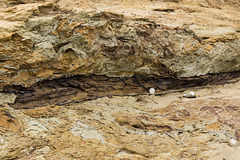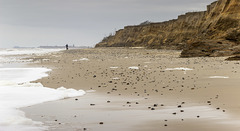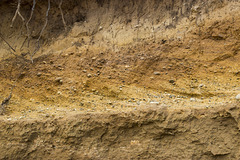
East Anglia
Photos taken in Norfolk, Suffolk and Essex.
Radar tower and estuary
| |
|
|
The radar tower and groynes in the Stour estuary at Languard Point, Felixstowe, Suffolk.
The Essex coast near Walton-on-the-Naze is visible on the skyline.
Marching out to sea
| |
|
A trail of markers on the end of groynes in the Stour estuary at Languard Point, Felixstowe, Suffolk.
The Naze Tower is visible on the skyline.
Southwold beach huts
| |
|
|
Colourful beach huts shut up for the winter on the North Parade at Southwold, Suffolk.
Southwold convergence
| |
|
On a somewhat grey afternoon at Southwold - a northwards view along the sea wall and beach towards Easton and Covehithe in the distance.
Look - but do not empty your dog
Please avoid emptying your dog in Southwold
| |
|
You should you not empty your dog here - even for 20p.
Sign seen on a money-in-the-slot telescope on North Parade, Southwold Suffolk.
Benacre Broad at low tide
| |
|
Benacre Broad National Nature Reserve adjacent to the coast in north Suffolk was previously a brackish water lake separated from the North Sea by a narrow barrier of sand and shingle. Now the barrier has been once again breached by the sea, it is a salt-water lake. This is in an area of active coastal erosion (up to 7 metres per year) and currently the highest rate of retreat in the UK.
Benacre Broad and breach channel
| |
|
Benacre Broad National Nature Reserve adjacent to the coast in north Suffolk was previously a brackish water lake separated from the North Sea by a narrow barrier of sand and shingle. Now the barrier has been once again breached by the sea, it is a salt-water lake. This is in an area of active coastal erosion (up to 7 metres per year) and currently the highest rate of retreat in the UK.
Benacre Broad breach channel to the North Sea
| |
|
Benacre Broad National Nature Reserve adjacent to the coast in north Suffolk was previously a brackish water lake separated from the North Sea by a narrow barrier of sand and shingle. Now the barrier has been once again breached by the sea, it is a salt-water lake. This is in an area of active coastal erosion (up to 7 metres per year) and currently the highest rate of retreat in the UK.
Benacre Silver Birch (BW)
| |
|
Benacre cliffs in north Suffolk is an area of active coastal erosion (up to 7 metres per year) and currently the highest rate of retreat in the UK.
At this point, just north of the now-breached Benacre Broad, the beach is littered with the remains of trees as a result of the undercutting and erosion of the cliffs and land on which they were growing.
I think the grainy black and white treatment suits the subject well...
Benacre Silver Birch
| |
|
Benacre cliffs in north Suffolk is an area of active coastal erosion (up to 7 metres per year) and currently the highest rate of retreat in the UK.
At this point, just north of the now-breached Benacre Broad, the beach is littered with the remains of trees as a result of the undercutting and erosion of the cliffs and land on which they were growing.
Benacre cliffs: Norwich Crag cross-bedding detail
| |
|
Close-up view of cross-bedded sands and gravels of the Norwich Crag (early Pleistocene) at Benacre Cliffs, just north of Covehithe in Suffolk.
Height of section: approx. 1.3 metres. Full view of cliff here:
www.ipernity.com/doc/earthwatcher/39078910
Benacre cliffs - Norwich Crag cross-bedded sands
| |
|
Cross-bedded sands and gravels of the Norwich Crag (early Pleistocene) at Benacre Cliffs, just north of Covehithe in Suffolk.
This stretch of coast line is currently experiencing the most active coastal erosion in the UK, with average loss rates of around 7 metres per year. The cliffs are only recently formed and are growing in height. The land behind the cliff line is a gentle hill, therefore as the sea eats into the cliff line causing it to retreat westwards into the hillside, so the top of the cliff gets higher.
Norwich Crag at Benacre cliffs
| |
|
Benacre Cliffs, just north of Covehithe in Suffolk, are comprised of sands and gravels of the Westleton Formation, with beds of bioturbated clay; part of the Norwich Crag, early Pleistocene in age.
This stretch of coast line is currently experiencing the most active coastal erosion in the UK, with average loss rates of around 7 metres per year. The cliffs are only recently formed and are growing in height. The land behind the cliff line is a gentle hill, therefore as the sea eats into the cliff line causing it to retreat westwards into the hillside, so the top of the cliff gets higher.
Benacre Cliffs - Norwich Crag bioturbated clay wit…
| |
|
Benacre Cliffs, just north of Covehithe in Suffolk, are comprised of cross-bedded sands and gravels of the Westleton Formation, with beds of bioturbated clay; part of the Norwich Crag, early Pleistocene in age. Here, a fossil tree branch can be seen in the clay. 20p coin for a scale.
Looking towards Southwold from Benacre Cliffs
| |
|
Benacre Cliffs, just north of Covehithe in Suffolk, are comprised of cross-bedded sands and gravels of the Westleton Formation, with beds of bioturbated clay; part of the Norwich Crag, early Pleistocene in age.
This stretch of coast line is currently experiencing the most active coastal erosion in the UK, with average loss rates of around 7 metres per year. The cliffs are only recently formed and are growing in height. The land behind the cliff line is a gentle hill, therefore as the sea eats into the cliff line causing it to retreat westwards into the hillside, so the top of the cliff gets higher.
Benacre Cliffs cross-bedded gravels 2
| |
|
Cross-bedded sands and gravels underlain by bioturbated sandy clay. Westleton Formation; part of the Norwich Crag (early Pleistocene) at Benacre Cliffs, just north of Covehithe in Suffolk. Above the cross-bedded unit, blown sand merges into modern soil.
Benacre Cliffs cross-bedded gravels 1
| |
|
Detail of cross-bedded sands and gravels of the Westleton Formation; part of the Norwich Crag (early Pleistocene) at Benacre Cliffs, just north of Covehithe in Suffolk.
Jump to top
RSS feed- Latest items - Subscribe to the latest items added to this album
- ipernity © 2007-2024
- Help & Contact
|
Club news
|
About ipernity
|
History |
ipernity Club & Prices |
Guide of good conduct
Donate | Group guidelines | Privacy policy | Terms of use | Statutes | In memoria -
Facebook
Twitter


















